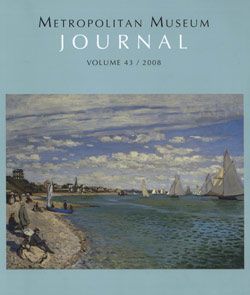Animal-Headed Figure Pendant
Not on view
Figure pendants topped with two dome-shaped elements are found over a wide area of Colombia, from the Tolima and Calima regions in the southwestern highlands to the Caribbean coast. They are among the earliest gold objects cast by the lost-wax technique and the image seems to have been made for at least a thousand years. The human figures are highly stylized and facial features are replaced or concealed by animal masks. The upright stance, arms, and hands holding batons are human features, while the face is that of an animal with a long, pointed snout and big, leaf-shaped ears. Atop the flat cap decorated with a lozenge pattern, the domes are an enigmatic feature; interpretations range from mushrooms to gourds to ceramic vessels.
The meaning of the figures is a matter of debate among scholars. Some have argued that the images represent shamans in a state of spiritual transformation, wearing masks and holding ritual objects. The flexed knees may refer to the seated posture traditionally assumed by the shaman when he meditates, divines, cues, or chants.
Due to rights restrictions, this image cannot be enlarged, viewed at full screen, or downloaded.


